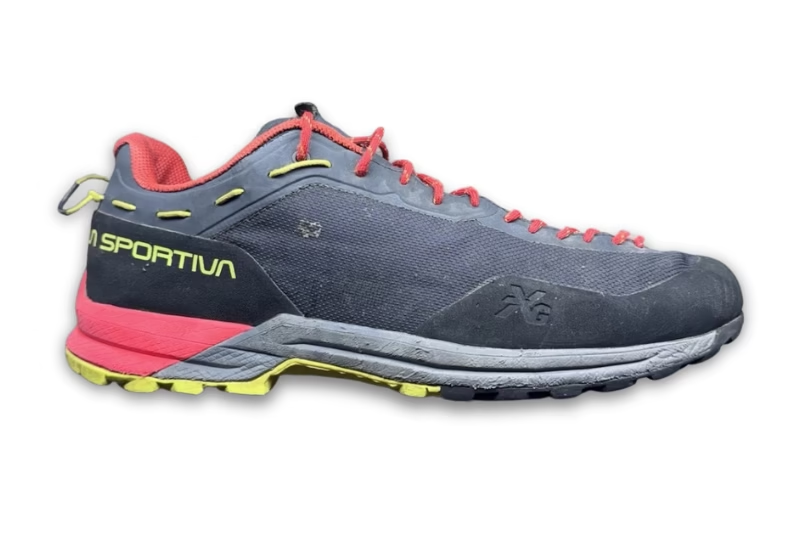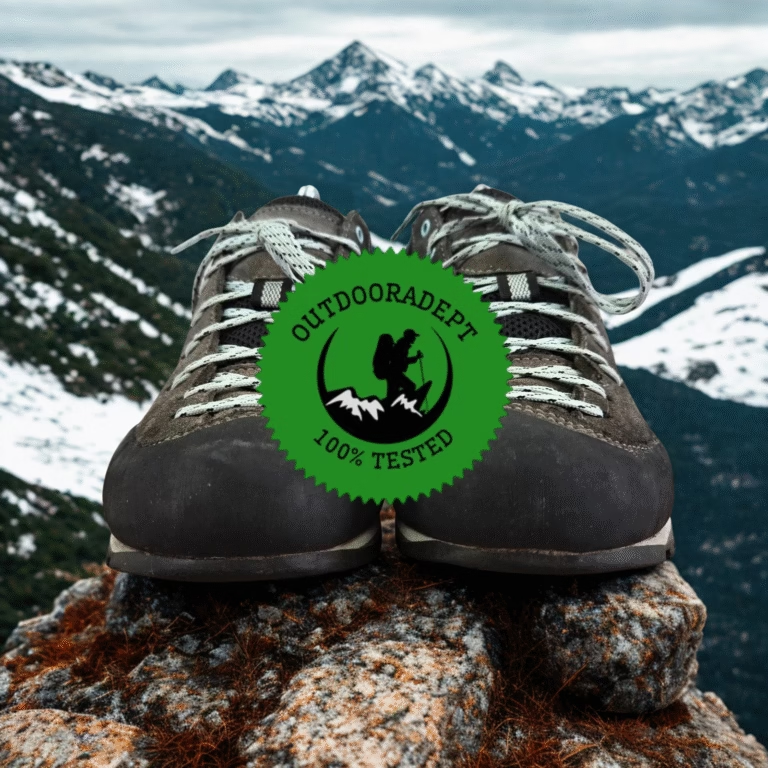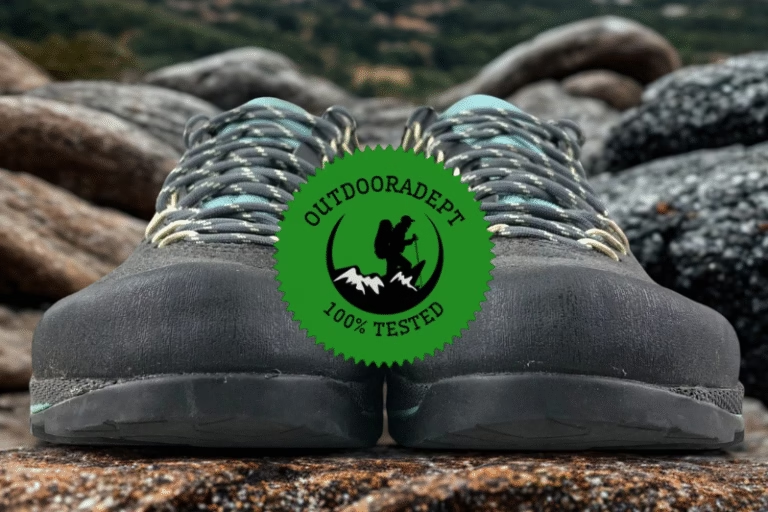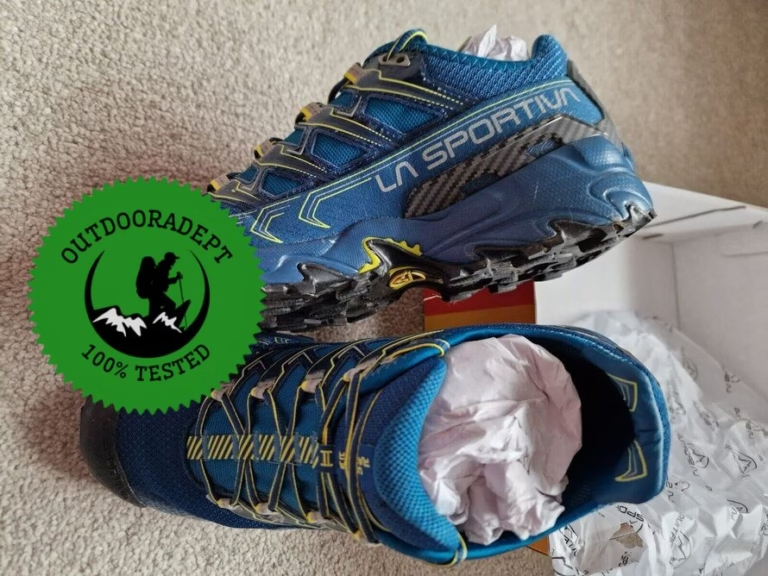I spent three weeks putting the La Sportiva Boulder X through demanding tests on Piatra Craiului Ridge in Romania’s Carpathians.
This narrow limestone ridge dishes out everything an approach shoe might face: exposed scrambles, technical traverses, and plenty of fourth-class terrain.
Our Verdict
The Boulder X takes a different approach than their modern lineup. It’s unapologetically heavy and built like a tank.

These approach shoes weigh nearly 1 lb. 13 oz. per pair in women’s sizing, which sounds excessive until you understand what that weight buys.
A full leather upper wrapped in a rubber rand? It laughed off sharp rocks that would’ve destroyed my old mesh approach shoes.
The board-lasted midsole provided stability I didn’t know I needed until I carried a heavy pack across technical ground.
The narrow toe box, though, that’s a dealbreaker for wider feet.
Check out my full La Sportiva Boulder X testing breakdown below.
If you want to compare the Boulder X to the regular La Sportiva hiking shoes, we’ve got you covered. We previously reviewed low-cut hiking shoes like the La Sportiva Ultra Raptor II and the La Sportiva Wildcat.
Highlights
| Feature | La Sportiva Boulder X |
|---|---|
| Weight | Women’s: ~1 lb. 13 oz. (≈ 850 g) per pair, US 7 Men’s: ~2 lb. 2 oz. (≈ 970 g) per pair, US 9 |
| Water Resistance | Water-resistant leather upper; not fully waterproof |
| Traction | Vibram® Idro-Grip V-Smear™ outsole; great grip on rock and technical terrain |
| Comfort | 2mm Polypropylene + Micropore EVA midsole with Ortholite footbed; firm, stable cushioning |
| Adjustability | Mythos-style lacing extends to toe for precise, customizable fit |
| Breathability | Limited; leather upper with minimal venting; better in cool conditions |
| Durability | Full leather upper with 360° rubber rand; abrasion-resistant and long-lasting |
| Support | Board-lasted construction with firm midsole; torsional stability for heavy loads |
| Toe Protection | Full rubber toe cap; reliable protection on rocky and technical routes |
Pros & Cons
PROS
CONS
Things We Tested When We Reviewed La Sportiva Boulder X

Traction
Piatra Craiului’s limestone stays slick with morning moisture, and that’s where the Vibram
Idro-Grip really showed what it could do. I’d step onto features the size of quarters and feel them grip rather than slide. My old trail runners would’ve had me white-knuckling every move.

What struck me about the tread pattern was how different it looks from hiking boots. There’s no deep lug design here, just rubber designed to maximize contact with rock.
That makes complete sense for approach shoes where edging matters more than mud traction. The dedicated zone under my toes handled smearing duties when holds vanished, giving me options on exposed sections.
Scree and loose dirt didn’t clog the treads, which kept traction consistent.
Heavy rain revealed the design’s limitations, though. Saturated clay had these shoes sliding where aggressive boot lugs would’ve bitten in. Steep grassy slopes posed similar challenges, as the rubber couldn’t penetrate wet vegetation effectively.
One pleasant discovery came during stream crossings. That sticky rubber held well to algae-covered rocks, letting me move across without excessive caution or scary moments.
Durability
Sharp limestone has a way of revealing construction flaws in rock climbing gear quickly. After three weeks of hard use, my Boulder X pair shows scuffs and scratches but zero structural damage.
The wraparound rubber rand proved its value repeatedly. Technical scrambling means jamming feet into cracks and kicking aggressively on steep terrain. The rand took this abuse in stride, maintaining protection throughout my testing without wearing through or separating.
The bonded toe cap shows no delamination signs. Roughly 80% of the original Vibram tread remains, suggesting these will deliver multiple seasons before needing professional resoling. The metal eyelets sit firmly in the leather without pulling or tearing.
Also, my heel lining remains intact despite reports from other users about this being a weak point. These feel like the kind of investment that pays off over years rather than seasons.
Comfort
Stiff leather footwear typically demands suffering through a painful break-in period. The La Sportiva Boulder X approach shoes started rigid and unforgiving. My first two outings left my feet aching after eight hours on the trail. I questioned whether these would ever feel comfortable.
Around 10 miles in, everything shifted. The leather began molding to my foot contours. Hot spots vanished. What felt like constraints transformed into support. The change was gradual but unmistakable.
The midsole stays firm rather than offering plush cushioning. Long descents meant feeling rocks underfoot, which generated some fatigue on extended days. But that firmness prevented the bruised sensation I get from softer shoes on technical terrain, so the compromise made sense.
Padding around the tongue and ankle collar prevented pressure points and the heel cup held my foot without allowing slippage on descents.
Once properly broken in, these approach shoes handled 10-hour days without complaint. The weight stayed noticeable throughout testing, though. My feet worked harder than with lighter rock-climbing shoes, especially on gentler terrain.

Breathability
All-leather construction comes with ventilation compromises. Lower elevation sections of Piatra Craiului had my feet overheating on warm afternoons. I found myself removing these shoes during every break just to cool down.
The forefoot uses unlined leather, while heel and tongue sections feature thin mesh lining. This hybrid construction helps marginally, but airflow remains limited compared to the mesh approach shoes I’ve tested.
Higher elevations told a different story. Cool days above treeline had the leather regulating temperature nicely without overheating. But once temperatures pushed past 20°C, ventilation became a real issue.
Temperate mountain conditions suit these shoes well. Hot environments will have you craving mesh construction.
Weight
At approximately 1 lb. 13 oz. per pair in women’s sizing, the La Sportiva Boulder X shoes aren’t light. Every ounce became apparent on long approach days, particularly when the terrain didn’t demand this level of support.
Clipping them to a harness seemed absurd – the bulk and weight make them impractical for that purpose.
Yet technical terrain revealed why the weight exists. These shoes maintained structural integrity under load. My feet stayed protected and aligned, where lighter options would’ve left me hurting.
Technical approaches with substantial packs justify the weight through superior protection and support. Just don’t expect nimble trail running characteristics or lightness for speed-focused objectives.
Waterproofing
No waterproof membrane means these rely on leather’s natural water resistance. Light moisture beaded off for maybe 15 minutes before gradually penetrating (fine for dew-covered grass or quick stream splashes).
A two-hour rainstorm on descent eventually saturated the leather completely. My feet got wet, which isn’t surprising without Gore-Tex. The rubber rand kept water from entering at the base effectively, but sustained precipitation always finds entry points.
Shin-deep stream wading didn’t cause immediate soaking. The leather held water out initially, buying time to reach the other side before wetness penetrated. Drying required over 24 hours, even with aggressive newspaper stuffing and air circulation.
The Boulder X Mid GTX offers full waterproofing through its Gore-Tex membrane and higher collar, though it runs even warmer and sacrifices what modest breathability the standard model offers.
Fair weather approaches work fine with these. But wet conditions demand planning and acceptance that dampness will occur.
Support
Board-lasted construction creates underfoot stability resembling light hiking boots more than flexible approach shoes. On long rocky descents, the soles resisted buckling against sharp stones, and my arches stayed protected throughout extended technical sections. That bruised forefoot feeling from inadequate support never developed.
Torsional rigidity mattered most on uneven ground. My foot couldn’t twist excessively, which proved critical when navigating off-camber boulder fields where missteps mean twisted ankles. The shoe held alignment rather than allowing rolling on irregular surfaces.
Low-cut design means minimal ankle support. You’re depending on sole rigidity and your own ankle strength rather than collar protection. For technical terrain with heavy loads, though, the support competes with entry-level mountaineering boots.
Fit and Sizing

Both shortness and narrowness characterize these shoes. My normal US women’s 8.5 required sizing up to 9 after researching recommendations. Even with that adjustment, the fit stayed snug initially, particularly through the toe box.
The narrow toe box dominated my first week’s experience. My average-width feet felt constrained before the leather stretched slightly. Wider feet will struggle – standard width is your only option.
The midfoot and heel sections fit narrow and secure, which helped during scrambling. Proper lacing eliminated heel slip. Full-length Mythos lacing enabled tension adjustment from toe to ankle, adapting the fit for different terrain demands.
The leather stretched about a quarter size across 50 miles. Initial forefoot tightness relaxed noticeably, shifting from uncomfortably snug to securely comfortable. This stretch means avoiding oversizing initially. The leather will give.
How Does It Compare with Other Products?
La Sportiva TX4

The most noticeable difference between these models is weight. The TX4 comes in roughly 10 ounces lighter per pair, which I felt immediately on extended approaches.
Both rely on sticky Vibram compounds for rock traction, though I’d give the TX4’s Megagrip a slight edge for all-around versatility across mixed conditions.
The fit tells a different story entirely. Where the Boulder X’s narrow toe box excludes many foot shapes, the TX4’s wider design accommodates more hikers comfortably, making it accessible to a broader range of feet.
Technical scrambling capability runs comparable between them, but the Boulder X’s stiffer platform delivers superior support when you’re hauling substantial loads.
The TX4 breathes marginally better and suits versatile terrain mixing approaches with trail hiking. For maximum protection on consistently harsh approaches, the Boulder X wins.
For more details of this approach shoe, check out our review of the La Sportiva TX4.
Scarpa Crux

The Crux retails around $159, matching the Boulder X’s price point, which makes the choice about priorities rather than budget.
The Crux employs leather and synthetic uppers that breathe better and weigh less, trading the Boulder X’s all-leather construction for improved ventilation.
While the Vibram rubber provides adequate grip, it doesn’t match the Idro-Grip’s performance on technical rock where precise edging matters.
The Crux’s greater sole flexibility creates comfort on easy trails, but that same flexibility proves inadequate on technical terrain when you’re carrying heavy packs.
At the same price, the decision comes down to intended use. Entry-level applications or occasional scrambling suit the Crux well.
For serious alpine objectives with heavy loads across multiple seasons, the Boulder X delivers superior protection, support, and the kind of construction that handles sustained aggressive use.
For more details of this approach shoe, check out our review of the Scarpa Crux.
La Sportiva TX Guide

Mesh construction shaves roughly 3 ounces per pair off the TX Guide while dramatically improving breathability compared to the Boulder X’s leather, which matters in hot conditions.
Both models use similar Vibram compounds that deliver comparable rock traction. The real divergence comes in the intended purpose.
The TX Guide’s even narrower last and tighter toe box prioritize technical climbing performance over hiking comfort, targeting difficult scrambles rather than long approaches.
Its more flexible sole creates nimbleness on rock but sacrifices the support you need for heavy pack carrying over extended distances, which the Boulder X offers.
Learn more about this product in our La Sportiva TX Guide Review.
Where La Sportiva Boulder X Performs Better
The Boulder X excels on technical alpine approaches, mixing substantial hiking with fourth-class scrambling. These shoes handle harsh, rocky terrain confidently: talus fields, limestone faces, exposed traverses where you need to trust your footing completely.
For multi-day objectives carrying 30+ pounds, the rigid platform prevents cumulative fatigue and bruising that lighter shoes allow. Shoulder-season conditions with variable weather favor the leather’s durability and modest water resistance.
Technical descents where changing shoes isn’t possible and exposed terrain demands confidence – that’s where these deliver.
Where La Sportiva Boulder X Falls Short in Performance
These aren’t the shoes for fast trail running or extended days on smooth, established trails where the stiffness and weight become more hindrance than help.
Hot weather exposes the leather’s limited breathability, so I’d reach for mesh alternatives in warm conditions without hesitation.
The narrow fit simply won’t work for wide-footed hikers, and there’s no width option to solve that problem. At 1 lb. 13 oz. per pair in women’s sizing, clipping them to a harness isn’t practical for multi-pitch climbs.
You’ll also need patience for the break-in period across 10-15 miles while the leather conforms.
Do We Recommend La Sportiva Boulder X?
My experience testing these on Piatra Craiului’s technical terrain convinced me they’re great approach shoes for demanding alpine use.
The traction kept me confident on exposed limestone scrambles. The durability showed zero structural damage despite aggressive use over three weeks. The support prevented foot fatigue while carrying heavy loads, which lighter shoes simply can’t match.
It’s true that weight became noticeable on gentler terrain, and the narrow fit requires sizing up half to full size.
But for technical approaches, scrambling, and mixed terrain with heavy loads where protection and support matter most, the Boulder X delivered capability that justified every ounce.
They’re specialized tools for serious mountain terrain.
Where To Buy It?
| WHERE TO BUY? | MEN | WOMEN |
| Amazon | See Pricing» | See Pricing» |
| Backcountry | See Pricing» | See Pricing» |
| REI | See Pricing» | See Pricing» |
FAQs
La Sportiva manufactures the Boulder X in their Italian factories. The company maintains production facilities in Italy, where they’ve been handcrafting mountain footwear since 1928, though some La Sportiva models are produced elsewhere.
The Boulder X excels on technical alpine approaches, fourth-class scrambling, via ferratas, and multi-day objectives with heavy loads. They’re ideal for harsh, rocky terrain where durability and support matter more than weight or speed.








